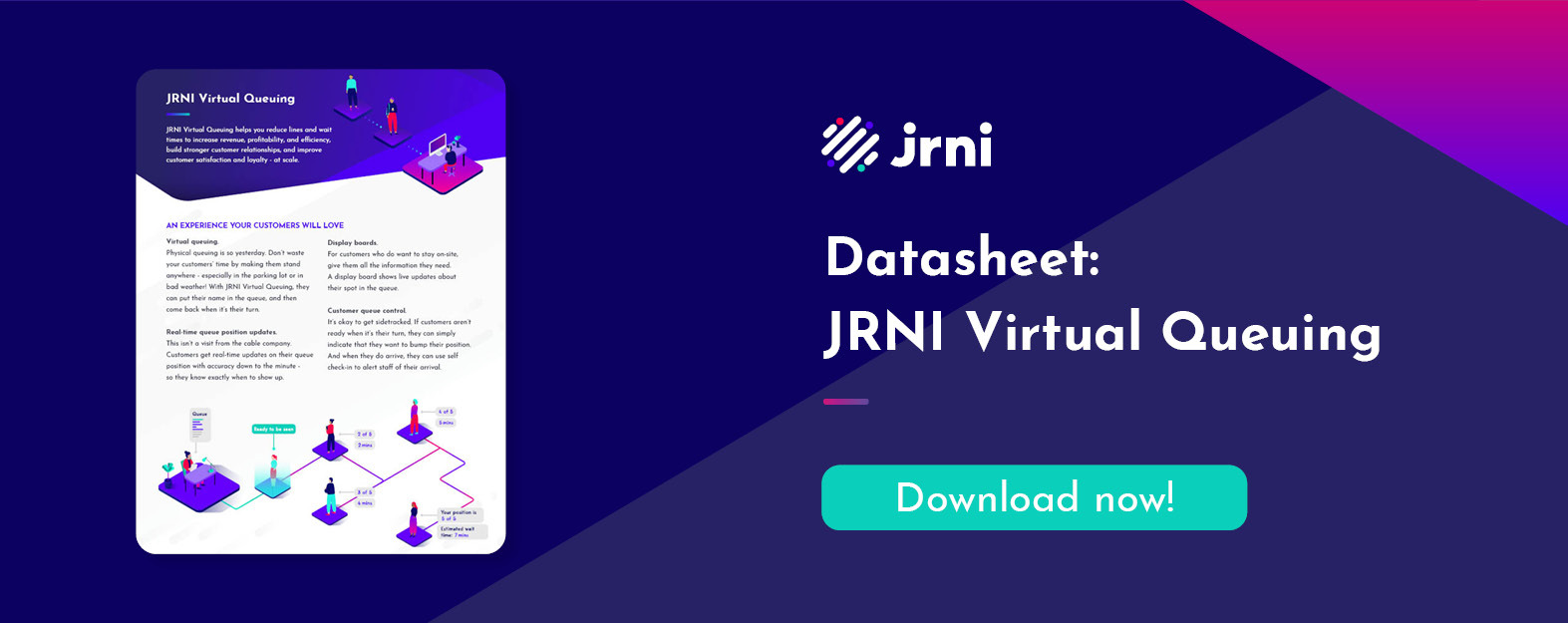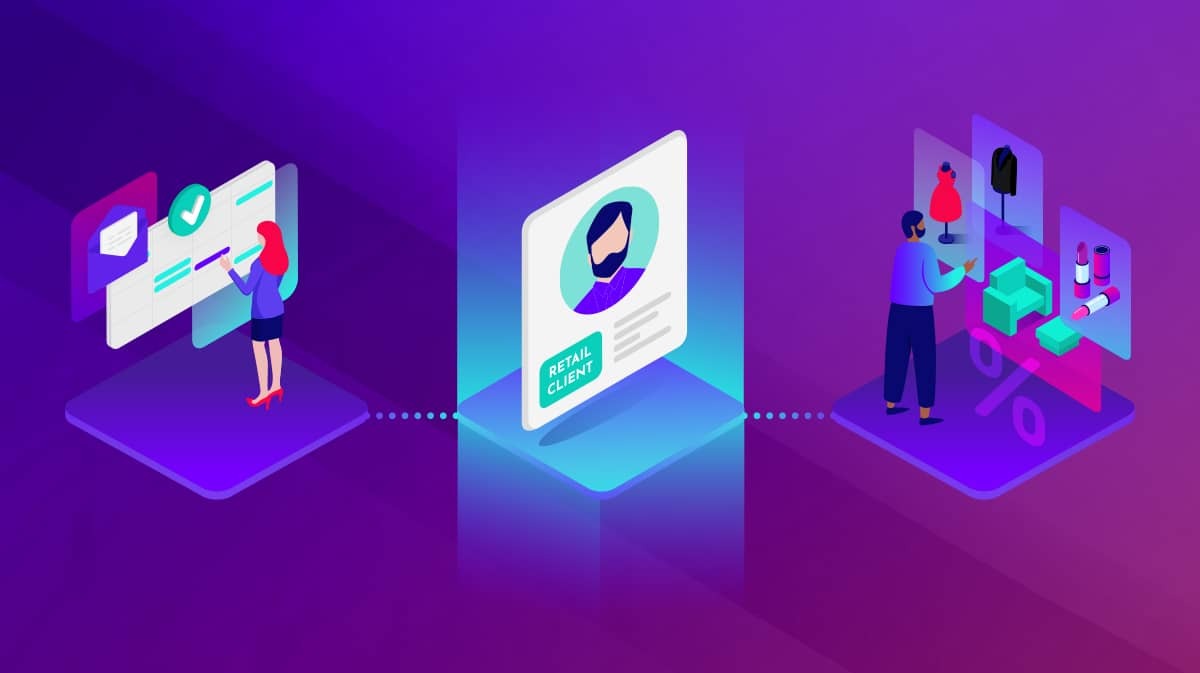Situations change daily, and organizations must adapt to the new normal as these changes occur. For service providers, the need for a safer environment for visitors and employees is more important than ever as the pandemic persists. This includes a focus on social distancing practices.
Consumer behavior is evolving, and as they increasingly crave better experiences, along with safe experiences, businesses are looking for ways to better accommodate their needs. One of the best solutions to keep social distancing in place, while also improving the waiting experience, is to use a virtual queue management system.
But what is a virtual queuing system? How does it work? We’ve put together a list of some of the most asked questions about virtual queues, the benefits of virtual queues, and how virtual queues enhance the customer experience.
How a virtual queue works
Virtual queuing allows businesses to set up online waiting lines, so customers can wait for assistance without physically standing in line. Virtual queue management solutions also give customers control to join a virtual queue from their mobile devices and receive a notification once it’s their turn for service.
What is a virtual queue?
A virtual queue is used as a way to manage lines and wait times to improve the overall customer experience. Employees also use virtual queues as a way to better manage customer flow.
Many of us have been in a virtual queue before, whether we realize it or not. For example, think about when you’ve gone on a ticket vendor’s website when there are thousands of other people trying to buy tickets to the same concert. You may have been placed in a virtual queue so that you had a “spot” in line to purchase tickets. Once it was your turn, you were notified that you could now enter the ticketing site and make a purchase.
For service-based businesses, virtual queuing saves customers from having to wait in a physical line or waiting room. Instead, they can wait in their cars outside or go take care of other errands in the area before being seen by an employee.
What is the purpose of a virtual queue?
During the pandemic, virtual queues have provided an easy way for customers to social distance and remain safe. In addition, virtual queuing also gives customers time back in their days, so they can take care of other errands or business without having to wait in a line or confined area.
Not to mention, virtual queues are a great way to retain customers since 70% of queuers would be less likely to return to an organization if they had experienced long wait times.
How are virtual queues used?
Several types of businesses use virtual queues for various reasons including product releases, high-demand ticket sales, university admissions, government applications, and much more.
Many service-based providers are using virtual queuing as an option for customers who want to schedule an appointment on the fly or to pick up an order. Additionally, virtual queues are being used for lobby management at places like doctor offices and banks.
Benefits of virtual queuing line management
Some benefits of virtual queue management include increased customer satisfaction, streamlined communication, improved customer flow, and reduced wait times. With a virtual queuing system, companies are also able to accommodate more customers.
How does virtual queuing management improve the customer experience?
Virtual queue management helps improve efficiency and the quality of service by giving customers the freedom to check their waiting status whenever they want to, which provides customers time to do more of what they want instead of waiting in line. Virtual queue management systems can also send the customer a predicted wait time and alerts when they are close to the front of the line. Additionally, customers can manage their place “in line” if they aren’t ready to be served. All of this leads to customers having a better experience, which leads to an overall positive outlook of your business.
Additionally, you can also collect data on your customers with a virtual queuing system. What service are they there for? What questions do they have? By gathering more information about your customers during this process, you can offer them more personalized service, helping increase customer satisfaction.
How does virtual queuing improve efficiency and quality of service?
Employees who don’t have to constantly manage the till can improve their productivity, efficiency, and overall quality of their service. By having more time to focus on what matters, they can complete urgent tasks and better accommodate customer needs.
How does virtual waiting line management reduce operational costs?
Increasing customer experience, improving efficiency, and reducing wait times are all great benefits for a quality virtual queue management system that can help reduce operational costs.
As you collect data, you’re able to identify and fix service bottlenecks that will end up saving you money in the long run. You will also be able to better see the peaks and valleys of your physical locations and ensure you have enough employees - and the right employees - on hand to help serve customers for their various needs. Also, by having a virtual queue system in place, you can save money on things like take-a-number systems and ticket machines.
The impact of virtual queues on the customer experience
As we’ve noted, virtual queues don’t just increase productivity for the business, they also can have a huge impact on the customer experience. Whether customers want to schedule a same-day appointment or secure a place in line, virtual queuing allows them to do what they want while they wait leading to a more enjoyable waiting experience.
How do long waiting lines affect customer spending and perception?
Studies show that customers won’t wait very long before leaving a queue. In fact, customers are only willing to wait 14 minutes before they’re served. Otherwise, they’re likely to leave with nothing.
We live in a society where instant gratification is a must, or at least gratification with little waiting time. This is because customers don’t want to waste their time waiting in lines: they’re busy people. Additionally, perception can be everything. Studies show that customers overestimate wait time by as much as 36%. Whether you provided fast service or not doesn’t matter in this case - it’s all about the customer’s perception of the wait.
How can a virtual queue system strengthen relationships with customers?
A virtual queue system is a great way to strengthen customer loyalty and relationships because it reduces waiting times and allows them to choose how they wait. This means that customers are more likely to come to your business because they know the experience is going to be much better than waiting somewhere else.
A virtual queuing system helps you provide experiences so great, it keeps your customers coming back for more!
Strategies for managing virtual queues
If you’re looking into virtual queuing solutions as an option for your business there are several important things to consider. Here are some of the best ways to streamline a virtual queue management system:
Set up a virtual queuing flow: Analyze how your current queuing process works and then decide how you want to change that. How do you want customers to join a virtual queue? Going online or on your mobile app? Or scanning a QR code at your physical locations? Do you want to have a single virtual queue or multiple virtual queues? There are many ways you could provide access to join your virtual queue.
Consult with your employees: You need to make sure that your employees are prepared to work with this new technology. What kind of training will they need? Who should be in charge of managing the virtual queuing system?
Try your virtual queue internally: Before bringing the system to the public, try it out within your company to see if there are any issues. Resolve any pain points or frustrations before launching it for your customers.
Keep monitoring: Customers and employees will likely have feedback as the system is being used, so be open to feedback to continuously improve.
Analyze reports: Keep track of the reporting with your virtual queuing solution. You should be able to make operational decisions based on reports such as peak times, purchases and other outcomes, customers issues solved, types of services requested, and more.
Physical lines are out, and virtual queuing is in! If you’re looking for a way to provide a pleasant waiting experience and improve both the customer and employee experience, then it’s time to consider a virtual queuing solution. If you want to learn more about JRNI Virtual Queuing, please reference our latest Virtual Queuing datasheet. You can also schedule a time to speak to one of our experts!




